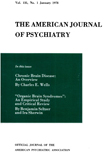THE "LAST STRAW": THE DECISIVE INCIDENT RESULTING IN THE REQUEST FOR HOSPITALIZATION IN 100 SCHIZOPHRENIC PATIENTS
Abstract
The decisive incident that forced a decision that a particular individual could no longer remain in the community and must be admitted to a mental hospital was studied from the point of view of the person making this decision. Descriptive data on 100 schizophrenic patients were analyzed to determine whether prompt medical and social work collaboration at the point of admission might prevent hospitalization.
Fifty-three patients actually committed or threatened to commit a dangerous act. Thirty-eight patients exhibited behavior that was socially unacceptable. Nine patients were perceived as needing treatment for illness. Only 4 patients requested hospitalization.
Demographic and social characteristics were not statistiscally significant in relation to the type of "last straw." As the number of hospitalizations mounted, the crucial event tended to progress from a mild behavioral change to threatening behavior, to actual assault. The final events were "family and community specific"and depended on particular standards and sensitivities.
Since many "last straws" are extreme and the family and the community have reached their limit of tolerance, the number of hospital admissions can be reduced only by extending care to the patient before his removal from the community is the only alternative.
Access content
To read the fulltext, please use one of the options below to sign in or purchase access.- Personal login
- Institutional Login
- Sign in via OpenAthens
- Register for access
-
Please login/register if you wish to pair your device and check access availability.
Not a subscriber?
PsychiatryOnline subscription options offer access to the DSM-5 library, books, journals, CME, and patient resources. This all-in-one virtual library provides psychiatrists and mental health professionals with key resources for diagnosis, treatment, research, and professional development.
Need more help? PsychiatryOnline Customer Service may be reached by emailing [email protected] or by calling 800-368-5777 (in the U.S.) or 703-907-7322 (outside the U.S.).



